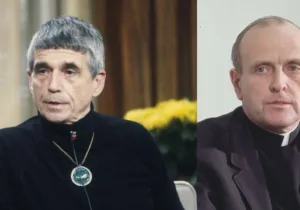The Trump administration was reportedly expected to release its plan for Israeli–Palestinian peace shortly after the Israeli election on April 9. Here is what you should know about the Israeli–Palestinian peace process.
What is the Israeli–Palestinian peace process?
The Israeli–Palestinian peace process is a term used in reference to the US-led attempts to bring reconciliation between Palestinian Arabs and the State of Israel. As William B. Quandt explains in his book Peace Process, “Sometime in the mid-1970s the term peace process became widely used to describe the American-led efforts to bring about a negotiated peace between Israel and its neighbors. The phrase stuck, and ever since it has been synonymous with the gradual, step-by-step approach to resolving one of the world’s most difficult conflicts.”
What is the origin of the Israeli–Palestinian conflict?
In AD 138, the ancient nation of Israel ceased to exist when the Roman emperor Hadrian crushed the Bar Kochba revolt and banned all Jews from Palestine (i.e., the biblical regions known as the Land of Israel). The land was conquered by various nations until 1517 when it was controlled by the Ottoman Empire. The Ottomans retained control until 1917 when the British captured Jerusalem during World War I.
During World War I, the Allies drove the Turks out of Ottoman Syria. After the war the British controlled the area of Palestine and was given a mandate by the League of Nations to administer the territory. The Jewish population in Palestine grew between 1919 and 1923 as Jews began to flee persecution in Russia and Ukraine. This influx of Jews, along with the Balfour Declaration, led the Arab inhabitants of the land to develop their own political movement, known as Palestinian nationalism.
As historian Martin Bunton notes, “Before the First World War, there was no ‘Palestine’ as such; rather the territory consisted of the districts of Jerusalem, Nablus, and Acre, all of which were defined according to an evolving framework of Ottoman administration.” Since then, Arabs in the region adopted a national identity as Palestinians, with the primary objective of opposing Zionism (i.e., the reestablishment of the Jewish nation of Israel).
In 1994, Israel agreed to allow the Palestinian National Authority, an interim self-government, to govern the Gaza Strip and parts of the West Bank. Thus, the Palestinian nation currently exists within the boundaries of the State of Israel.
What is necessary to resolve the conflict?
To achieve peace, both sides would need to reach an agreement on at least five issues of contention:
- The establishment of one or two states, and the defining of borders.
- The status of Jerusalem as the capital city of Israel and/or Palestine.
- The Israeli settlements in the West Bank, land claimed by the Palestinians.
- Right of return of Palestinian refugees living outside the region.
- Resolution of terrorist activities and violence promoted and carried out by Palestinians.
How has the US been involved in the peace process, and what has been the result?
From the beginning of the conflict in the 1940s, the US has played a key role in attempting to bring reconciliation between the Arabs and Jews. Since 1991, the US has been involved in five major attempts at negotiation:
Madrid Conference (1991)
Brokers: The event was hosted by Spain in the city of Madrid, but co-sponsored by the US and the Soviet Union.
Key Groups: Israel, Lebanon, Syria, and a Jordanian-Palestinian delegation.
Purpose and Outcome: The main accomplishment of the Madrid Conference was that it opened discussion between Israel and the Palestinians, and provided a framework for future engagement.
Oslo Accords (1993 and 1995)
Brokers: The Oslo Accords were the result of two secret meetings that were held in Oslo, Norway. Although the US was not directly involved, the Accords were based on US-negotiated Camp David Accords (1978), and the first Oslo Accords were officially signed at a public ceremony in Washington, DC, in September 1993. The Oslo II Accord was also witnessed in Washington, DC, by President Bill Clinton and by representatives of Russia, Egypt, Jordan, Norway, and the European Union.
Key Groups and Figures: Prime Minister Yitzhak Rabin represented Israel, while the Palestine Liberation Organization (PLO) and its Chairman Yasser Arafat represented the Palestinian side.
Purpose and Outcome: The Oslo I Accord recognized the Palestinian National Authority (PNA) as an interim self-government structure for the Palestinians and their representative in future negotiations. In exchange, the PLO acknowledged the State of Israel and vowed to reject violence. The Oslo II Accord established a Palestinian Interim Self-Government Authority for the Palestinian people in the West Bank and the Gaza Strip. This agreement was for a transitional period not exceeding five years, with the expectation that it would lead to a permanent settlement based on UN Security Council Resolutions 242 and 338.
Camp David Summit (2000)
Brokers: The US sponsored the summit at Camp David (known formally as the Naval Support Facility Thurmont), the president’s country residence.
Key Groups and Figures: President Bill Clinton hosted Israeli Prime Minister Ehud Barak and PLO Chairman Yasser Arafat.
Purpose and Outcome: The summit was arranged to discuss the issues of borders, security, Israeli settlements, Palestinian refugees, and Jerusalem. It ended without an agreement, which both Israel and the US blamed on Arafat’s intransigence and refusal to bargain in good faith. Soon after the failure of the summit, the second Palestinian intifada (which means “shaking off” in Arabic) broke out, leading to a new cycle of violence.
Road Map for Peace (2003)
Brokers: The Quartet on the Middle East— the US, the United Nations, Russia, and the European Union—which was first established at the Madrid Conference.
Key Groups and Figures: The Roadmap was a plan produced by the Quartet based on a speech given in 2002 by President George W. Bush that offered a two-state solution (i.e., the State of Israel and the State of Palestine).
Purpose and Outcome: The purpose of the plan was to establish clearly defined benchmarks and goals for progress in the Israeli-Palestinian peace process, with the aim of reaching a comprehensive settlement by 2005. The plan was divided into three phases: Phase I was to end violence associated with the Second Intifada, a return to the pre-Intifada territorial status quo, a rebuilding of Palestinian institutions and a freeze on Israeli settlement activity; Phase II was to include the establishment of a Palestinian state; Phase III was to be devoted to permanent status negotiations. The Road Map was abandoned after it failed to stop the violence of Palestinians.
Annapolis Conference (2007)
Brokers: The US hosted this conference at the United States Naval Academy in Annapolis, Maryland.
Key Groups and Figures: President George W. Bush, Israeli Prime Minister Ehud Olmert, and Palestinian President Mahmoud Abbas.
Purpose and Outcome: The purpose of the conference was to revive the peace process by implementing the Road Map for Peace.
Joe Carter is an adjunct professor of journalism at Patrick Henry College, an editor for several organizations, and the author of the NIV Lifehacks Bible.
Photo Credit: Israeli Prime Minister Yitzhak Rabin, President Bill Clinton, and PLO Chairman Yasser Arafat at the White House on September 13, 1993. By the Executive Office, via Wikimedia Commons.







 Sponsor a student for Christianity & National Security 2024
Sponsor a student for Christianity & National Security 2024